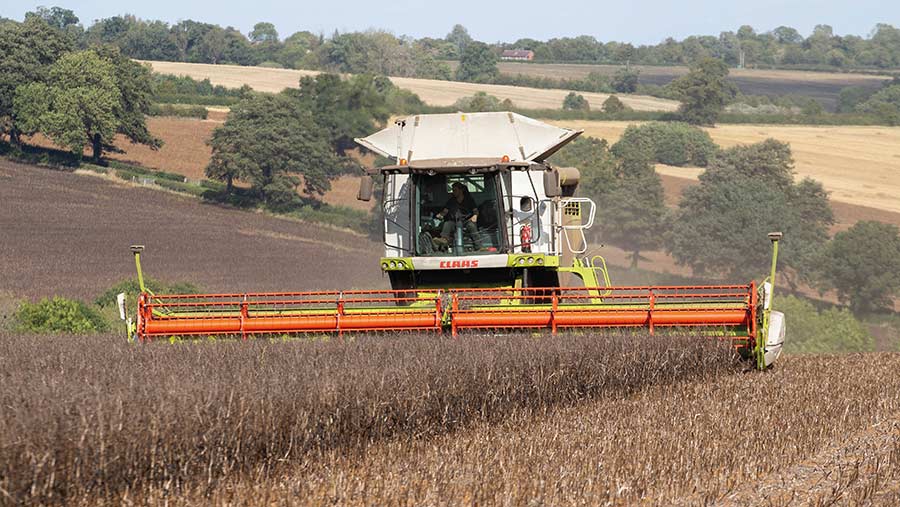Winter bean choices include market leader-beating variety
 © Tim Scrivener
© Tim Scrivener A high-yielding winter bean variety which offers a 10% yield uplift on the current market leader is set to benefit bean growers next season as commercial availability widens.
The variety, called Vespa, offers improved standing ability and a larger seed size than the mainstay variety Tundra, with a yield potential of 109% versus 99% on this year’s Processors and Growers Research Organisation (PGRO) Descriptive List.
As popularity for pulses continues to rise and markets remain strong, the variety is certainly something for growers to consider when making next season’s cropping choices.
See also: Tackling rust and chocolate spot in beans post chlorothalonil
A good all-rounder
Tom Yewbrey, seed sales manager at seed breeder Senova, explains that the variety is a good all-rounder, which performs well across all soil types. “Vespa is high-yielding, with good agronomic traits, making it very suitable for both growers and traders,” he says.
It has improved standing ability, taller straw length and a higher thousand grain weight than Tundra, but with very similar agronomic practicalities, he says.
With an 8 for standing ability, it shares the highest lodging resistance score with the variety Honey, despite it being the second-tallest variety on the list after Bumble. “With a good protein content, large seeds and a pale hilum also on offer, it is suitable for both the feed and export markets,” adds Mr Yewbrey.
The only pitfall, he admits, is its slightly later maturity than Tundra (5 versus 6), but this difference is minimal and will only affect growers in the north of England and Scotland, where Honey is recommended instead, due to it’s earlier maturing characteristic.
Consistent performance
Steve Belcher, PGRO’s principal technical officer, talks of Vespa’s good all-round performance, where trial data over the past two years demonstrates a particularly good run, while performance of Tundra has begun to fall away. “It’s unusual for a high-yielding variety to maintain such a consistent performance, but Vespa seems to be holding up well,” he says.
Despite being on the Descriptive List since 2018, he believes Vespa will only gain popularity now that seed supplies have become more commercially available. “Tundra is currently the variety with the largest area planted in the UK, superceding Wizard, which was once the variety of choice. It will now be Vespa and Tundra that battle it out for the top spot.”
New varieties for 2021
The PGRO’s Steve Belcher introduces two new varieties added to the 2021 Descriptive List: Vincent and Norton. “Although seed is limited, these varieties are certainly ones to look out for, showing real potential in trials,” he says.
Vincent offers outstanding yield potential, now placed as the highest yielding variety, with a 110% yield percentage. It also provides a very large thousand seed weight, which processors increasingly look for due to the associated larger bean-to-skin ratio, says Mr Belcher.
With a higher protein percentage of 28.1% – compared with other varieties that stand between 25.9-26% – Vincent should prove popular for both feed and export markets. Furthermore, it is a later-maturing, pale-hilum variety, with tall, stiff straw and good standing ability.
The second addition to the list is Norton, a high-yielding, pale-hilum variety with a yield percentage of 107%.
It is early to ripen and suitable for all regions, including wetter areas of the UK and the North. It has good standing ability and particularly large seed.
Winter beans – PGRO Descriptive List 2021 |
||||||
|
|
Yield (% of control) |
Earliness of maturity (1-9) |
Straw length (cm) |
Standing ability at harvest (1-9) |
Thousand seed weight (g) |
Protein content (%) |
|
NEW: Vincent |
110 |
4 |
129 |
7 |
849 |
28.1 |
|
Vespa |
109 |
5 |
126 |
8 |
686 |
26.1 |
|
NEW: Norton |
107 |
7 |
125 |
7 |
726 |
26.2 |
|
Bumble |
104 |
4 |
132 |
6 |
703 |
25.6 |
|
Tundra |
99 |
6 |
119 |
7 |
650 |
26.0 |
|
Wizard |
96 |
6 |
122 |
7 |
682 |
26.4 |
|
Honey |
92 |
7 |
116 |
8 |
699 |
25.9 |
|
• The control for yield is the mean of 4 and 5 year varieties (4.54t/ha) |
||||||

